This post may contain affiliate links which may generate a small commission from clicks that result in a purchase.
Olive trees can be grown in many different styles and shapes. They can be kept small, making them ideal candidates for bonsai olive trees. Or they can grow bushy and wide, filling up the whole corner of your living room.
Shaping olive trees to grow bushier, wider, fuller, or even taller all require formative pruning. Formative pruning involves strategically trimming back the young olive tree stems, branches, and leaves to encourage growth or to prevent growth, depending on what the long-term goal is.
Firstly observe your young olive tree and carry out formative pruning as desired. Keep reading to learn 2 different pruning techniques and how you can implement them into your olive tree maintenance based on your goals.
2 Techniques to Shape Olive Trees: Formative Pruning
If you have just got your olive tree and it looks spindly, but you want a full, bushier tree, you’ll need to do some strategic pruning to encourage growth. This is pretty much the only way to get a fuller-looking olive tree.
I will explain 2 different techniques suitable for young olive trees, ideally from one year old until their formative pruning is completed after about 4 to 5 years.
*Most olive trees sold in garden centers will already be at least partially pruned and trained, so you can skip the first-year steps that are not relevant in your case.
1. Shaping a Central-leader Standard Olive Tree
If you want to make your olive tree with a clear central-leading branch that grows upwards ahead of the other branches and becomes taller, bushier, and wider, this technique is for you. This technique is perfect if you want your olive tree to look natural and wild fitting to your backyard setup, also, you do not care so much about commercial growing.
The most important is not to cut this central leader branch, as this could spoil the desired shape of your olive tree.
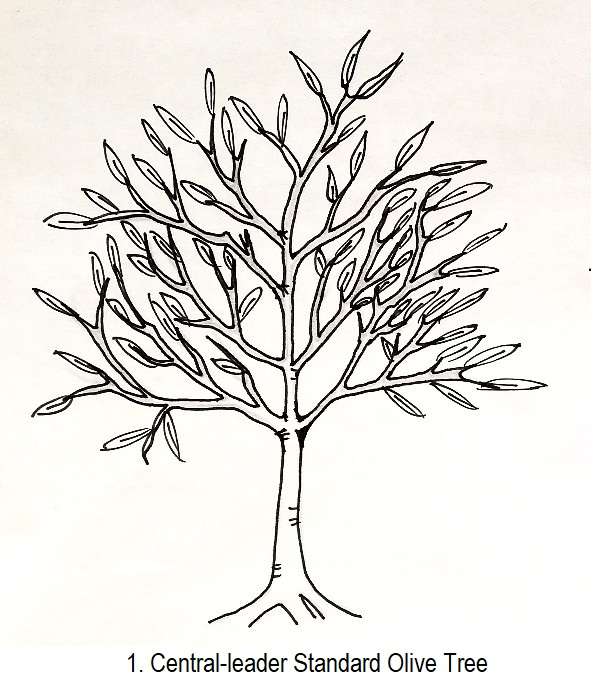
First Year
- Divide the main stem of your olive tree into 3 parts.
- Trim off side branches and leaves from the lowest part of your olive tree. Keep the main stem clean and clear.
- Cut by half all the side shoots on the middle part of the main stem of your olive tree.
- Leave the side shoots on the top part of olive tree untouched. Just remove any dead, diseased or damaged branches and leaves.
- Remove any inward facing buds in order to prevent the growth into the centre of the olive tree. Seek to keep outward buds only.
Second Year
- Trim off completely the side shoots that were shortened by half in year one (which should be now in the lowest part of the olive tree)
- Cut by half the side shoots on the middle part of the olive tree
- Get rid of any crossing or misplaced branches in the top part of the olive tree
Third Year
Follow the same steps as for the second year.
Fourth and Fifth Year
- Clear the olive trunk of side shoots and branches to the height you desire
- Continue to remove any crossing, misplaced, dead or diseased or misplaced branches in order to shape the form you want
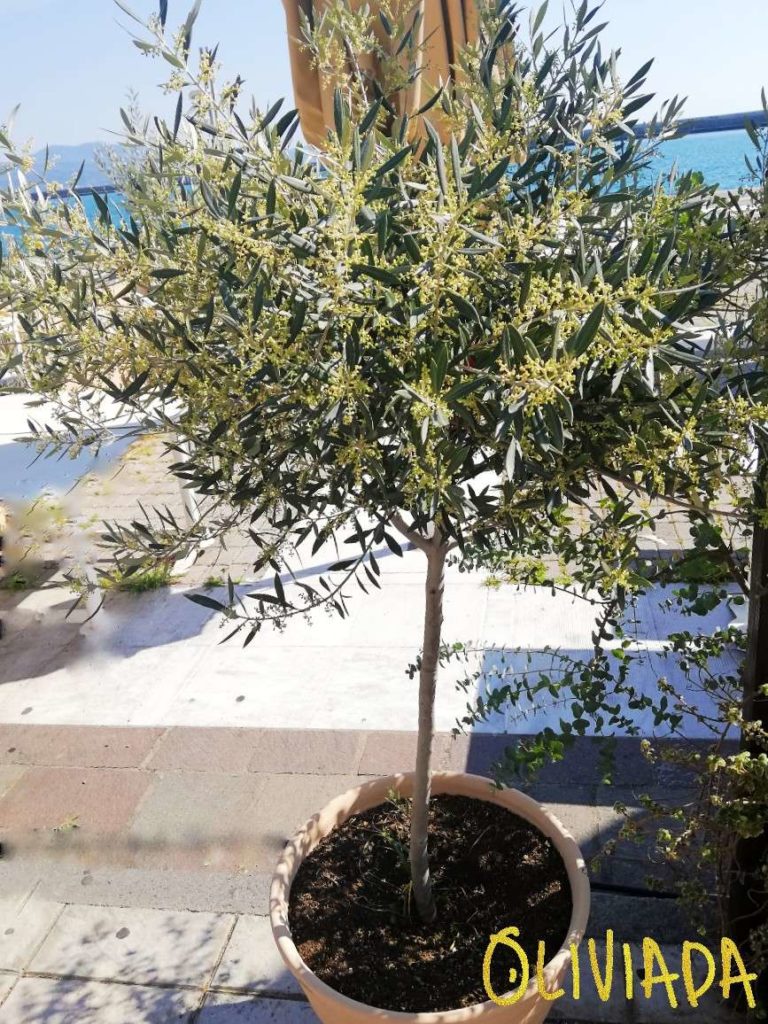
2. Shaping Open-centered (Vase Form) Olive Tree
This technique is suitable for your olive tree if you want to control its size, make it bushier, wider and increase olive fruit production. This formative pruning way is perfect for commercial olive tree growers in order to maximize yield.
You can reduce the final height of your olive tree that would otherwise grow as a central-leader branch (see 1 technique) by removing the leader branch and shaping an open-centered (vase form) olive tree.
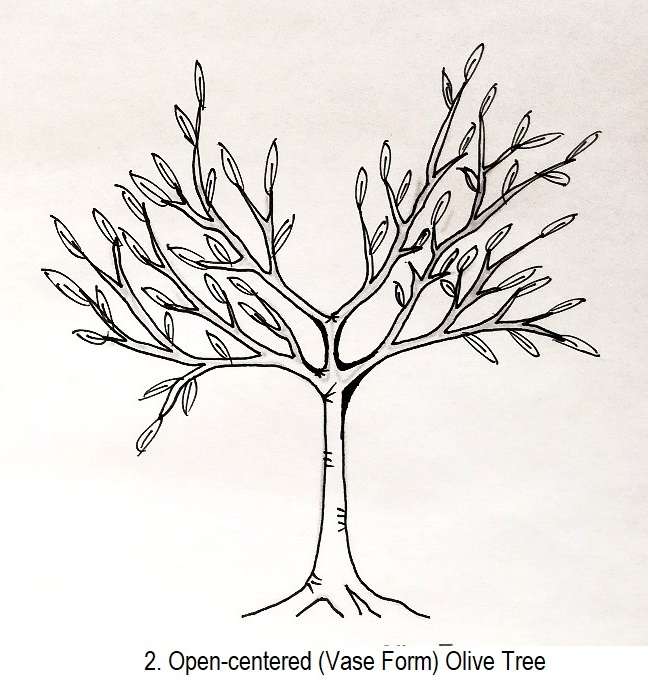
First to Third Years
Follow the steps above as for a central-leader standard olive tree (see 1 technique).
Fourth Year
- Cut back the leading olive branch, cutting to an uppermost strong side shoot
- Leave 2 or 4 side shoots in the top part of the olive tree untouched to form the branches (and form the open-centered or branched-head canopy). Only get rid of any badly placed branches or those that are crossing or rubbing
- Cut the side shoots on the middle part of the olive tree by two-thirds in order to keep stubs that can replace branches if needed
- Get rid of all side shoots from the lower part of the olive tree and keep the main trunk clean and clear
Fifth Year
- Get rid of any strongly upward-growing (vertical) branches that threaten to dominate the canopy and spoil the shape you desire
- Eliminate any crossing or rubbing branches
- Cut back the canopy branches and side shoots a little to balance the shape of your olive tree. Cut to an outward facing bud to encourage open growth of your olive tree
- Clear the desired height of olive trunk of any growth you desire. If you see that this pruning encouraged a new growth from the olive trunk, clear off the shoots as soon as they emerge
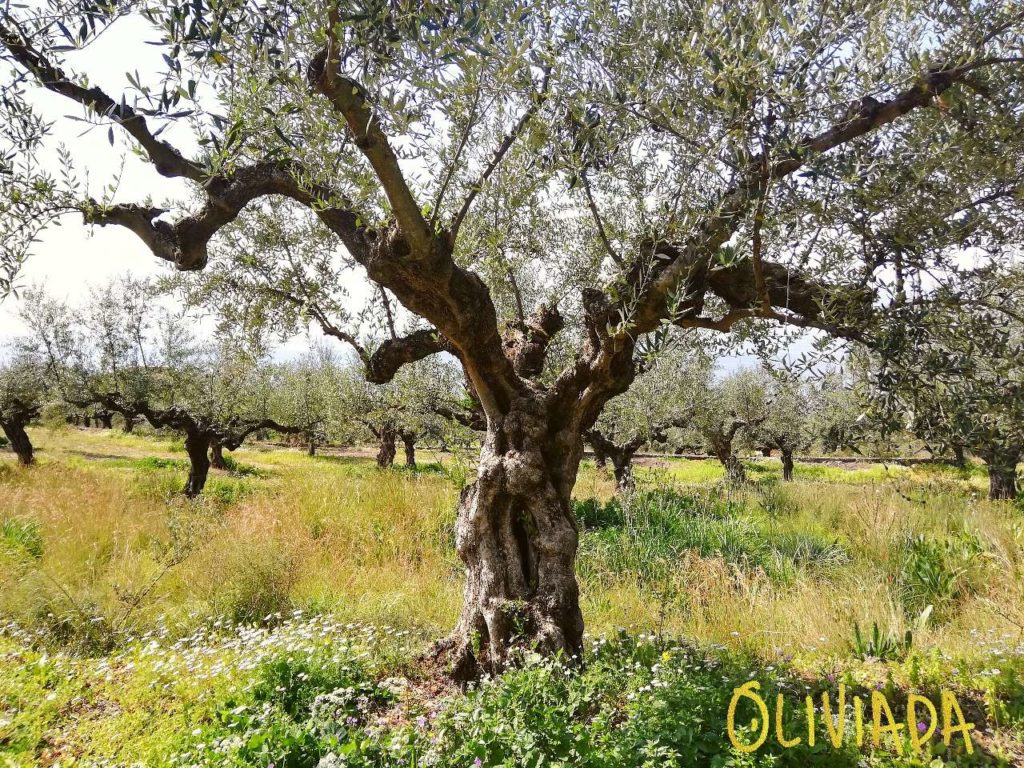
Also, check out my article on how tall olive trees grow and the olive tree root system.
Problems with Shaping Olive Trees
Where upright shoots threaten to compete with the leader branch of your olive tree, then a single leading shoot will have to be selected, and the others removed. Select one that is upright and in line with rest of the olive tree.
Where the leader branch of your olive tree is damaged by wind, snow, or by accident, cut it back to a strong side shoot that is growing fairly vertically. Attach a bamboo stick to this side shoot and tie the shoot into the bamboo stick as it extends, training it upwards as a new leader of your olive tree.
Multiple Trunks Olive Tree
If you have a young olive tree with multiple trunks, it’s crucial to take action early on to prevent the trunks from growing too far apart and eventually splitting. This can lead to stunted growth and lower productivity.
Here are some easy steps to help you entwine the trunks of your young olive tree:
- Step 1: Determine the best time to entwine the trunks of your young tree. It’s best to do this in the first few years of its life when the trunks are still flexible. Avoid doing this when the tree is older, and the trunks have become more rigid.
- Step 2: Decide on the best method to use. You can use soft tree ties to gently pull the trunks together or a rubber hose or PVC pipe split down the middle to wrap around the trunks and hold them together.
- Step 3: Prepare the materials you need. If you use soft tree ties, ensure you have enough to wrap around both trunks. If you use a rubber hose or PVC pipe, cut it to the appropriate length and split it down the middle.
- Step 4: Secure the trunks. If using tree ties, gently wrap them around the trunks and tie them together. Be careful not to tie them too tightly, as this can damage the bark. If using a rubber hose or PVC pipe, wrap it around the trunks and secure it with zip ties or wire.
- Step 5: Monitor the tree regularly. Check on the tree periodically to make sure the ties or tubing are not too tight and are not damaging the bark. If you notice any damage, loosen the ties or tubing.
- Step 6: Remove the ties or tubing once the trunks have grown together and are stable. This usually takes a few years, so be patient and monitor the tree regularly.
Generic FAQs
When is the best time to shape olive trees?
Shaping olive trees is often carried out at the end of winter or early spring prior to new growth and once the risk of frost has passed. Though random light trimming can be done any time of the year.
How do I make my olive tree trunk thicker?
If your olive tree grows indoors, try to move it outside in spring-summer seasons and expose it to air movements. Because the movement of air means the olive tree trains and develops a much thicker, more resilient trunk. It’s the reason trees are not firmly tied to a rigid stake from top to bottom when planted, to allow some movement to take place.
How do I stimulate olive tree growth?
Fertilize the olive tree each month from spring to summer for the first year with a fertilizer containing slow-release nitrogen. In subsequent years, space the fertilizing every four to six weeks. Do not fertilize in winter.

Final Thoughts
Formative pruning and shaping olive trees is an unknown thing to beginners’ olive tree growers, but it’s a necessary part of tree maintenance and care. All you really need to successfully shape your olive tree is a good understanding of your ultimate goal on how to shape your tree, what you need to trim, and when.
If you want to grow your olive tree as wild and natural as it is, select 1 technique and shape a central-leader standard olive tree. To make your olive tree bushier, wider & fuller, choose 2 technique and shape your olive tree open-centered. This way you not only shape olive trees in a commercial way but will increase olive fruit production every year.
Bear in mind, structural or formative pruning should be done as early as possible. Cause the older is the tree, the more difficult to shape it in the way you desire.
If you’d like more information about pruning olive trees in pots and tools to use, feel free to check out my recent post:
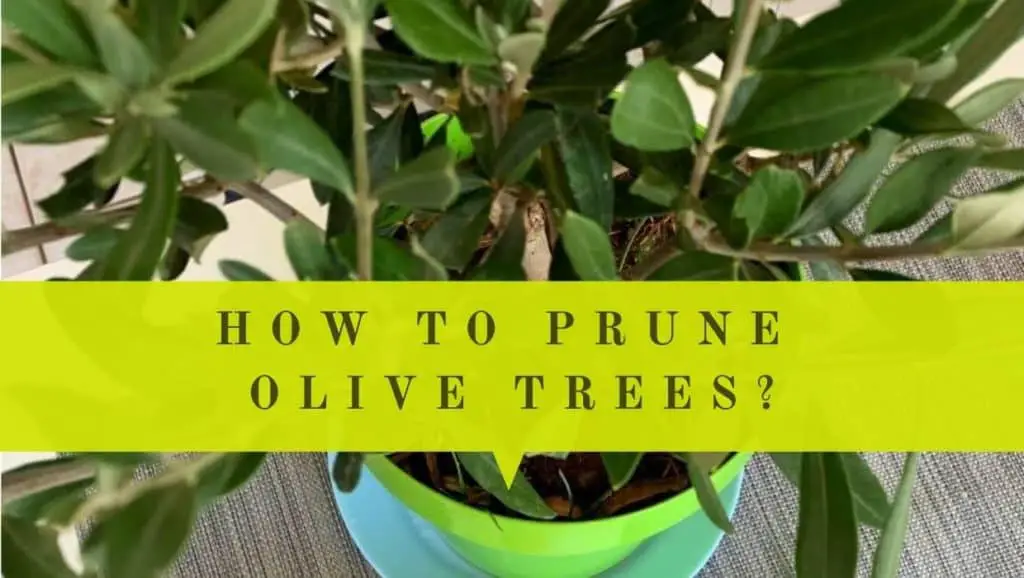
Related Topics
- 5 Best Olive Trees for Landscaping
- How to Care for Olive Trees in Pots
- How to Propagate Olive Tree From Cuttings?
- Where do Olive Trees Grow Best?
Hi, I’m Vangelis Kleftogiannis, the founder of Oliviada and an established olive oil expert from Kalamata, Greece. My expertise isn’t just in producing quality Extra Virgin Olive Oil, but also in the cultivation and care of olive trees themselves. I am deeply committed to sharing my knowledge and know-how, helping others understand the intricacies of olive tree growing and the creation of quality olive oil.
Are You Looking to Buy an Olive Tree?
If you are looking to add more potted trees or other plants to your orchard, or if you like to replace a neglected olive tree, the best places to get them are your local nursery or an online nursery.
One of the most reliable and the world's largest online nurseries is Fast Growing Trees. They deliver fast, neat, and healthy plants backed with a 30-day guarantee.


Recently, I planted three 125 year old olive trees with a very bushy ball crown. Can olive trees take formative pruning in any season? The objective is creating a taller tree with five or six main branches. My Moroccain gardener here on the Mediterranean tells me to wait for spring.
Hi Thor, if it is going to be heavy pruning it is better to wait until early spring or after the last freeze. Though it depends on where you are based and how harsh winters are there in your region. The main concern is to have enough time for the olive trees to heal after pruning and not to be exposed to the freezing weather in the winter. Also, we dont prune olives during growth season: flowering, fruiting up until harvest.
Live in London. I have a 10yr old Olive tree which has become quite tall and only has healthy growth at the top and weak branches further down. The lead branches grow rapidly upwards with little new growth further down. How do I prune this?
HI Isabelle, you can cut back the lead branch by one-third to focus on strength rather than height. Get rid of the weakest branches. Also, fertilize your olive tree regularly to make it thrive.
I have a potted olive tree that I purchased a year ago that is split at the base just above the soil. Each of the two “trunks” is about 3/8″ in diameter or so. Both trunk sections are about the same height, about 3 1/2 to 4 feet form the top of the soil. Up until now, I’ve had both trunks tied to a stake. I would like to make this a single trunked tree to make it more of a lollipop shaped tree. One of the splits is the perfect tree shaped with a central trunk, whereas the other is not so pretty but just as tall.
My question is – would it hurt the tree to cut off one of the splits to make it a single trunked tree? Should I just love it as it is and prune accordingly? thank you!
Hello!I have an olive tree in a 10 inch pot that I got nine months ago that is shy of 6 feet. It is split at the base just above the soil with two trunks. Am I able to cut one of the trunks off to make it a single trunk tree without harming the tree?
Also, can the cuttings be propagated?
Thanks so much!
Hi Dana, there is no harm to cut off one of the splits and make a single-trunked olive tree. A lollipop-shaped tree sounds great! :)
Hi Dana again, yes you can propogate cuttings, read more about it in my article: How to propagate olive trees from cuttings.
Hi. Help please. I have a 3 year old olive tree in the ground, all very healthy and lots of fresh growth/blossom but its width is getting wide and bushy but not any taller. How can I correct this please as it looks more like a shrub than a tree. I’ve only ever trimmed it lightly and there’s a lot of lower level stems coming out. Thanks
Hi Jay, it sounds like your olive tree has a shape of a wild olive tree (without any pruning done in its early years). Definitely, your olive tree needs hard pruning where lower-level stems should be cut off. Your final pruning goal should be to have one core central trunk and four to six main branches. In general olive trees have the tendency to grow in width and growing many new stems it focuses their energy on maintaining these new branches rather than delivering height.
How can I entwine both trunks of my young tree
Hi Debbie, this is an excellent question. I have added this information as a separate section in an article. Hope this is helpful
Hello, from România!!!
Why my tree dont make olives?
First have many flowers , after that make small olives and after 1 or 2 weeks the olives fall down.
Hi Paul,
The issue you’re facing with your olive tree is not uncommon and is usually referred to as “fruit drop”. This can happen for a variety of reasons.
– Pollination Issues: Olive trees are partially self-fertile but they will produce better with cross-pollination from another variety. If there aren’t enough pollinators around, or if the weather during flowering is particularly cold or rainy, pollination may not occur effectively, causing the fruit to drop.
– Watering and Nutrition: Inconsistent watering or a lack of essential nutrients can stress the tree, causing it to drop its immature fruit. Try to maintain a regular watering schedule and consider a balanced fertilizer designed for olive trees.
– Temperature and Weather: Sudden changes in temperature, high winds, or a late spring freeze can also cause olive trees to drop their fruit.
– Overproduction: Sometimes, olive trees produce more flowers than they can sustain as fruit. The tree may naturally drop some fruit to conserve resources.
Ensure regular watering, a balanced diet for your tree, protect it from harsh weather, and consider getting a second olive tree variety for cross-pollination. Also read my article about olive tree not fruiting.
Best of luck!